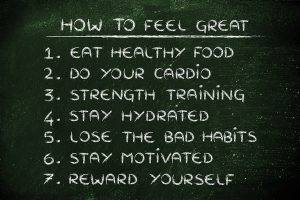 It’s up to every senior to find a fitness program that works and that they will do regularly no matter what. It’s not a matter of “it-would-sure-be-nice-to,” but really a requirement for seniors who want to live long and disease free. Because let’s face it, who wants to live long when they’re sick all the time?
It’s up to every senior to find a fitness program that works and that they will do regularly no matter what. It’s not a matter of “it-would-sure-be-nice-to,” but really a requirement for seniors who want to live long and disease free. Because let’s face it, who wants to live long when they’re sick all the time?
This means seniors are required to work-out and exercise:
- Aerobic or cardio training a minimum of 150 minutes per week (reaching and maintaining your target heart rate for 30 minutes each session).
- Strength training a minimum of three days per week to increase muscles, bone density, and reduce the signs and symptoms of many diseases and age-related conditions,
- Eating right to get the proper nutrition (i.e. eliminate sugars and bad fats) and caloric intake, and
- Avoiding toxins (i.e. pesticides used in foods, processed foods, alcohol, chemicals, preservatives, artificial sweeteners, air pollution, microwaving food in plastic containers).
Now, I know some of you are thinking: who has time for all this, even in retirement? How can I do all this? Life is too short!
Well, I get it. But if we don’t set Smart Senior Fitness Goals, how do we keep the muscles and strength we have? How do we stave off all those diseases that are rampant among aging people? I present an ideal scenario. In reality, it’s up to you to find your own fitness routine.
Your health and longevity is in your hands. Now none of us are perfect. Some of us set up routines and then fudge our way through them. Still, even with excuses and injuries and soreness, we can achieve Fitness for Seniors by following the 85 percent rule.
The Magic of the 85 Percent Rule
What has worked well for most of my friends is to follow the 85 percent rule. Follow the ideal path 85 percent of the time, and 15 percent of the time, do whatever you want. If you do that, you will be just fine. Imagine what cutting out all sugar 85 percent of the time could do for your body and health. Imagine exercising routinely – except for 15 percent of the time when you don’t feel like it!
Success comes from being disciplined yet fair and kind to your self-expectations. Just be aware when you give in too often to your bad habits and slide into wanton lack of self-discipline and sloth.
Get Real and Address Bad Habits
Be aware that many of your “bad habits” are unrecognized addictions. More than you know, you are prone to do things because of your brain and it’s addictive need to scratch the itch of a dopamine fix. Can you live without caffeine? Are you addicted to sugar? What’s going on inside your neural pathways? Are you feeding your bad habits by giving in to a quick fix of dopamine several times a day?
I’m not trying to beat you up here. But let’s face it: we are a generation of addicts. We live for feel-good quick fixes and instant gratification.
We’ve spawned whole industries that greedily cater to our dependencies, like the fast food, tobacco, caffeine, sugar, and pharmaceutical industries, who have built empires by addicting us to their products. Those short bursts of pleasure that make us feel (chemically) better about ourselves and our crazy world often don’t seem to bother us much in our third, fourth and fifth decades, but when we hit the senior years―watch out!
Switch Out Bad Habits for Good Ones
One way of altering an addiction is to rewire neural pathways. This is done through action. The more you work-out, the more you create new neural pathways and good habits. Then the dopamine fix is satisfied by adherence to good healthy habits instead of food, drink, and sloth.
We can substitute good habits for bad habits by taking action and developing an exercise and fitness “fix.” In a very short time, you start to experience the highs of dopamine and endorphins created by vigorous exercise. This will eventually replace other addictions mentioned above. It’s just as much fun, and it pays off in good health and happiness.

Recent Comments